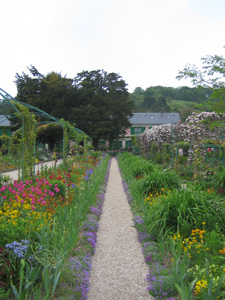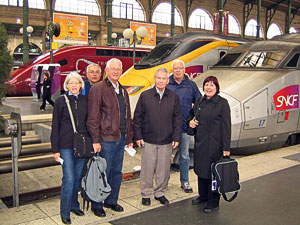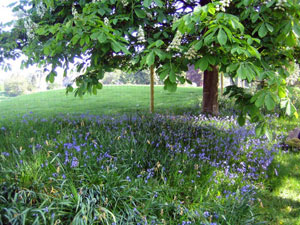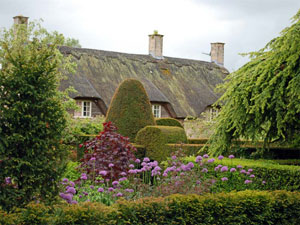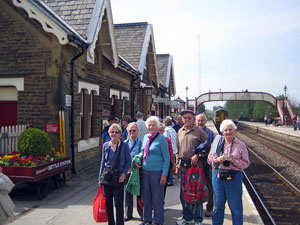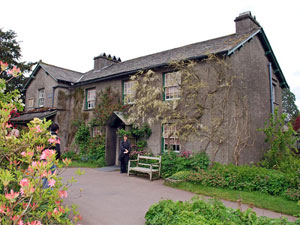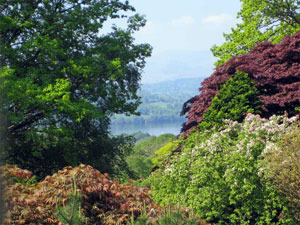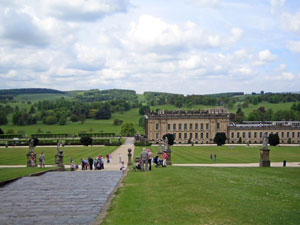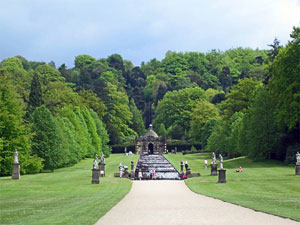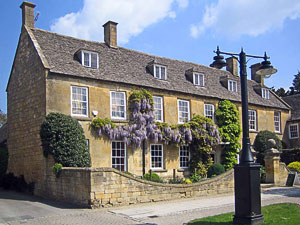Europe’s Springtime Gardens
Europe’s and England’s Gardens in the Springtime
Amsterdam
Wednesday
I was out at Amsterdam’s Schiphol Airport bright and early this morning to meet the tour members of the Springtime Gardens Tour. The Singapore Airlines, Malaysia Airlines and Cathay Pacific flights all arrived within 20 minutes of one another before 7am.
We could have begun our rail tour of Europe by taking the train from the airport into the city, but it is only 12 minutes and, with our luggage, it was a better idea to chart a bus. It whisked us to our hotel in Central Amsterdam. It has been the Golden Tulip Amsterdam City Centre for ages but is now renamed the Inntel Hotel.
A few tour members had paid last night’s accommodation to ensure that their rooms would be ready on arrival. The others were keen to start sightseeing. Our hotel is in the very heart of Amsterdam. Behind the hotel is the main drag of Amsterdam, the Damrak. It runs from the Railway Station to the Royal Palace at Dam Square. Fanning out around the Damrak is a series of concentric (oblong) with beautiful canal houses which look unchanged since the 17th century when the Dutch ruled the greatest maritime empire the world had ever seen.
Dirk Hartog and Abel Tasman were Dutchmen who got to the Great Southland - New Holland - well before the Brits.
The correct name for this country is the Netherlands. Nederland, the locals call it. To be precise (or pedantic) Holland is the name of the counties of the Netherlands around Amsterdam. The seat of parliament is The Hague (den Haag), but the Queen lives in Amsterdam, the largest city and commercial and cultural hub. The Netherlands is a prosperous constitutional monarchy with a robust parliamentary democracy.
I didn’t have to be back at Schiphol until midday for the people arriving on the British Airways flight, so I offered to take those interested to Anne Frank’s house, nearby. It really is only a walk, but we took the tram so that they could learn the tram system - so easy. So, those who asked why we didn’t begin our tour of Europe by rail at the airport, were relieved to learn that we would be seeing Amsterdam by rail, tram rails. I have been to Anne Frank’s House half a dozen times, but am still deeply moved by this visit.
I gave the tour members directions to get by tram to the Rijksmuseum - home of Rembrandt’s Nightwatch and thousands of other famous paintings - and the Van Gogh Museum, while I headed back to the Airport.
We met in the cosy hotel bar, around the open (gas) fireplace at 6pm for Welcome Drinks and brief introductions. There are tour members from all Australian states except Tasmania, from New Zealand and from Canada. Our (included) Welcome Dinner was in Bogarts, next door. Praise for the choice of restaurant was universal. A good start to the tour.
Amsterdam
Thursday
We met in the hotel foyer for an 8.30am departure this morning to enjoy a canal cruise through Amsterdam’s history. We chartered our own canal cruiser and English language guide, avoiding the pre-recorded commentary (and jokes) in 8 languages.
After an early lunch we met again at 12.30pm to travel through the Dutch countryside on the first of our gardens tours - Penny won the jellybean for being first to spot a windmill - to the pretty village of Limmen. Limmen is not on a railway line, so train tours are not possible. Again today we chartered a coach.
Limmen is the home of the small, historic Hortus Bulborum, established in 1928, but with tulips dating from 1595, as a gene pool for the Dutch bulb industry. There are 3,500 different tulip, hyacinth and daffodil species. The preservation of heirloom bulbs is a major project in the Hortus Bulborum. Many of them have no commercial value for modern mass production; the aim, rather, is to keep these cultivars for future generations.
Tulipmania reached fever pitch in the 1630s - when some Amsterdam people mortgaged their houses to buy one tulip bulb, with the hope of propagating and selling on to make their fortunes. Makes our stockmarket look golden!
We were back in our Amsterdam hotel by late afternoon. Given the long evenings at this latitude, I offered an afternoon / evening visit to the city of Delft, not usually on the gardens tours itineraries, but a beautiful town with strong art associations. Unlike Limmen, rail tours to visit Delft are the most convenient - four trains an hour from Amsterdam, and about an hour’s journey. Delft was Vermeer’s home town. The town is much more beautiful than portrayed in the film “Girl with a Pearl Earring”. The canals and buildings hint at what Amsterdam might have looked like in its Golden Age. When the shoppers were finally coaxed out of the shops (bags bulging with beautiful blue and white Delftware), we had dinner together in a restaurant on the edge of a canal in this beautiful town. Back on the train for our return journey.
Amsterdam
Friday
A tour highlight today - Keukenhof, a must on all gardens tours. Again, no train tours are available to Keukenhof because it is well off the tracks. Our charter bus had us there in 45 minutes, despite some heavy traffic. We spent a full day today absorbing the majestic beauty of one what I think is one of the world’s finest bulbfields. The Keukenhof Garden has 80 acres of winding paths, gurgling streams and placid ponds offer an exuberant feast for the eyes. There are tulips, daffodils, hyacinths and other flowering bulbs, flowering shrubs, ancient trees, indoor exhibitions, flower parades, and no fewer than seven themed gardens. Little wonder we allocated a full day to visit the Keukenhof!
Keukenhof is situated on what was a hunting area in the 15th century. Herbs for the kitchen of the castle of Jacoba van Beieren were collected here; hence the name of the area is Keukenhof - “kitchen garden”. A garden was designed around the castle, in the English landscape style, and was the forerunner of the present Keukenhof.
The local council organised a Flower exhibition here in 1949 and from that time Keukenhof has grown to become one of the world’s best known and best loved gardens, a focal point of most of Europe’s gardens tours.
When we became a little footsore we had plenty of options for coffee and lunch. Everybody was back at the agreed meeting point at 4pm for the drive back to our Amsterdam hotel.
Paris
Saturday Top
Everyone had their bags out by 8.30am and I checked them on to the van. There was time for one last stroll along the canals before meeting in the hotel foyer to cross to the Amsterdam Centraal Station.
We began our love affair with Europe’s great train tours on perhaps the best of all - the Belgian / French Thalys train. We travelled across the Netherlands and into Belgium. After Brussels, on the high speed track, the train reached its cruising speed of 300 kph. Talk about the great (and comfortable) rail journeys of the world! All train tours should be like this. I took out my laptop and logged-on: there is free internet access on this train. I didn’t do much work but it looked impressive. The stockmarket is down again, but the Australian dollar is the strongest it has been against the Euro, ever. We enjoyed our free lunch, including a hot dish, served at our seats. I warned the group not to get too used to it as this and the Eurostar are the only European trains on our tours which give us a free meal.
Our plan had been to transfer directly to our hotel, have lunch and then do the city sightseeing tour. But we had had lunch on the train, and aware that our luggage (which was not travelling at 300kph) wouldn’t have arrived yet, we did our city orientation tour in our charter bus on the way to the hotel.
From the Gare du Nord Station we were soon into the heart of the fashionable Right Bank: the Paris Opera House, and the Place de la Concorde - where the grisly guillotine was set up during the revolution. Penny won the jellybean for being first to spot the Eiffel Tower. We turned onto the Champs Elysees, perhaps the world’s most famous street, running from the Place de La Concorde to the Arc de Triomphe. The Arc de Triomphe, the world’s largest triumphal arch, was commissioned by Napoleon to honour his Grand Armee.
Fabulous views of the Eiffel Tower from Trocadero (a photo stop), then across the river to the Left Bank, past the base of the tower. The stately parliament buildings and Napoleon’s Tomb were on the right hand side as we commenced driving down the Boulevarde San Germain into the heart of the Latin Quarter and our hotel.
We settled into the hotel and met again at 4pm for a walking / orientation of “our” very special corner of this beautiful city. It is as if we have our own French village nestled around the Maubert Mutalite Metro station, 100 metres from our hotel - an ATM, a post office, pharmacy, laundry and dry cleaner, several very agreeable brasseries, and food shops galore. The aromas are mouth-watering.
100 metres on beyond the Metro station, (and past the patchwork and embroidery shop) we were suddenly on the Left Bank of the Seine, offering what is, in my opinion, the best external view of Notre Dame. From here we could enjoy the view of the cathedral with its Gothic spires and flying buttresses sitting in the Seine. Group photo opportunity for the website!
We went into Notre Dame and everybody was wowed by the fabulous Rose windows. It has been a bright and sunny day, so the stained glass was at its best. We gathered outside and I told my “lunchwrap of Notre Dame” joke before we broke up to do our own exploring.
We met again in the foyer at 8pm and took the Number 63 bus to Trocadero, where we had taken our Eiffel Tower this afternoon, and had dinner together in the bistro overlooking the twinkling Eiffel Tower. We see why Paris is called the City of Lights. For a few tour members this was the first visit to Paris. I envied them.
Paris
Sunday
Out of Paris today for two absolute “must sees” on all gardens tours - Versailles Palace and Monet’s Garden.
It is Sunday morning - no crowds - and we are on a touring Europe by rail, so we settled on the one of Europe’s great train tours, under Paris on the Metro. From the Metro terminus we took the bus to Versailles.
The Sun King Louis XIV who reigned from 1643 to 1715 as an absolute monarch built the magnificent Versailles Palace over 50 years, 25 kilometres south-west of Paris (now suburban).
Millions of French peasants died of starvation while the Bourbon kings lived here in fabulous luxury. Hollywood tells us that the rampaging peasants stormed Versailles and destroyed the magnificent furnishings during the Revolution. Not so. The Revolutionary Commune sold off the furnishings to various European royals and American millionaires. They are gradually being bought back now, but only 14 of the 300 rooms have been fully restored
I used my “Mary Antoinette really let her head go over this place” joke, and then explained why I believe that the Hall of Mirrors is at the heart of the tragedy of twentieth century world. It was the setting for the signing in 1919 of the Treaty of Versailles, which purported to end World War 1 but which, by its harsh terms, precipitated World War 2, which precipitated the division of Europe between the Communist east and the democratic Capitalist West for another 45 years.
The gardens were being prepared for the water display this afternoon. Handel’s Water Music was already playing. Our visit over, and morning coffee, we located our charter coach for the drive on to Monet’s Garden at Giverney. Giverney is not on the railway line, so train tours are not possible. We travel through French countryside leaving Ile de France and crossing into Normandy. The village of Giverney was Monet’s home for more than 40 years.
There are two parts to Monet's garden: a flower garden called Clos Normand in front of the house and a Japanese inspired water garden on the other side of the road. The two parts of Monet's garden contrast and complement one another. Claude Monet did not like organized nor constrained gardens. In the Clos Normand he married flowers according to their colours and left them to grow rather freely. In the water garden is the famous Japanese bridge covered with wisterias, other smaller bridges, weeping willows, a bamboo wood and above all the famous nympheas (water lilies).
The wisteria on the Japanese bridge was at its very best. Everybody had their photo taken on the Japanese Bridge, under the wisteria blooms. Watch out website.
Paris
Monday
We departed the hotel at 8.30am - before the traffic - for our day in the country to visit two of France’s grand gardens - Chateau Vaux-le-Vicomte and Fontainbleau. Again, these should be compulsory inclusions on all gardens tours. We chartered a coach again today a neither garden is on the railway line, so train tours were not possible.
We began at Vaux-le-Vicomte. The forerunner of Versailles, the Chateau Vaux-le-Vicomte was laid out in 1661 and includes a parterre, immaculately clipped topiary yew, water features, reflective pools, and a grand canal with grottoes on one side and a cascade on the other. The chateau is well preserved and French movie fans recognized it as the generic 18th Century aristocratic chateau from a dozen movies. There is an interesting coach museum which most of us visited before having lunch in the restaurant called “Squirrel”.
We moved on to Fontainbleu. Unlike Vaux-le-Vicomte which sits on a country road, Fontainbleu is the focal point of the sizeable town of the same name.
Once the noblest garden in all France, Fontainbleau was built for a king, Francois I, who wished to rival the great courts of Italy. Though the old knots and statuary have gone, enough of the 1528-1547 layout survives to give one a sense of how gardens were arranged in sixteenth century France. Le Nôtre designed a large parterre, between 1661 and 1664, on the site of the former Grand Jardin. The 1200 metre-long canal also remains. The Jardin Anglais, made during 1811 and 1812 continues to fascinate.
Back in Paris, I took those interested for a visit to Sacre Coeur and to the nearby Artists’ Quarter at Montmartre for dinner.
A short (uphill) walk from the ANVERS Metro station brought us to the funicular (rack railway - one metro ticket, Europe by rail, remember) up to the hilltop basilica. The architectural style is called Romano - Byzantine, and it is the only church in this style in the world that I know. The basilica is only a hundred years old, built with the proceeds of a public appeal after France’s disastrous defeat in the Franco-Prussian War. Sacre Coeur was a focal point for the French resistance to the Nazi occupation of Paris in the Second World War.
A 100 metre walk from the basilica brought to the Place de Tetre and its artists’ colony. Here one can buy original paintings of Paris street life or, for $300, can have an absolutely atrocious portrait sketched. This is where Puccini’s opera “La Boheme” (The Bohemians) is set. I used my “your tiny wallet is frozen” joke. Art shops, restaurants and coffee shops abound around the square and down the numerous alleys leading off the square.
Paris
Tuesday
Most of the group wanted a day in the museums, galleries and shops (the Louvre is closed Tuesdays), so it was only a small party who went to visit the Somme battlefields of World War I today. Back to train tours today. Paris by rail on the Metro to Gare du Nord, where we joined France’s flagship train, the TGV, for 20 years the world’s fastest train [the new Shanghai Airport train goes faster]. It may not be the most picturesque of Europe’s rail tours but it is one of the fastest. Almost to the English Channel in 50 minutes.
Our excursion included a drive around the sites associated with the costly July 1st, 1916 push immortalised now as the Battle of the Somme. More men died on this one morning than in the whole of the 9 month Gallipoli campaign.
We began with a visit to the Newfoundland Memorial at Beaumont Hamel where the trenches have been preserved - here 80% of the army of tiny Newfoundland was wiped out in ten minutes from 7.30am on July 1st, 1916, slaughtered like cattle.
We proceeded to the Australian Memorial at Poziers. Here five thousand died in a night. Then, the British Memorial at Thiepval. At La Boiselle we visited the huge crater left by the mine explosion set off for the newsreel cameras 10 minutes before the attack began on July 1st, 1916. This blast alerted the Germans that the attack was on, so they simply mowed down the Allies as they rose from their trenches.
In the afternoon we visited Villers Brettoneux, and its Australian war cemetery. Here are the 11,000 names of all those Australian soldiers from World War I who have no known grave. At Villers Brettoneux, Australian soldiers stopped the last German push of March 1918. The schoolchildren of the State of Victoria raised money throughout the early 1920s and paid for the reconstruction of the village school in Villers Brettoneux after it was levelled along with the town in 1918. The village school is still called the Victoria School. The town hall in Villers Brettoneux flies the Australian flag and proudly displays not one, but two kangaroos on the town’s coat of arms.
We were a subdued group as we made our rail journey back to Paris for our last night. How could we get such useless waste of young lives out of our minds? John’s summing up said it all: “If the old men who declare wars had to fight in them, there wouldn’t be so many wars.”
Paris To Yorkshire, UK
Wednesday Top
Our last morning in Paris. There was tropical fruit on the breakfast fruit platter so I was able to make my “last mango in Paris” joke.
We were transferred to Paris’ Gare du Nord Railway Station. Check in is rather like an airport check-in, with French Customs and Passport Control, then UK Customs and Passport Control, then Security. The “under the English Channel” Eurostar, must rate on everybody’s list of the great rail journeys of the world, and should be included on all rail tours of Europe. It travels at 300kph on the French side, slows down through the tunnel (this takes 20 minutes) and speeds up again to deliver us into the heart of London, St Pancras Railway Station, in under two and a half hours.
On board (First Class, of course, on the Great Trains of Europe Tours, as on all of Europe’s best rail tours) we were served a complimentary hot meal. We moved one time zone West and so gained an hour.
On arrival, we crossed the road to King’s Cross Station (literally across the road) and joined our British InterCity train which took us along the route of the Flying Scotsman to York at 125 miles an hour. The Brits still do lovely things like miles instead of kilometres, real tea and real fish and chips. But they do litres for petrol but pints for beer. Who knows why?
We were in York in time for a great English institution - afternoon tea. The purists insisted on clotted cream, not just the whipped stuff. Forget the diet: support the dairy farmers. There was time to stroll through the ancient city heart with its narrow mediaeval shopping street called the Shambles and visit the historic York Minster.
There is no rail service from York to the village of Pickering, so our transfer was by coach. The White Swan is the “poshest” pub in the village and its restaurant is widely regarded and rewarded. The Yorkshire blue cheese and leek risotto was from heaven.
Yorkshire
Thursday
European breakfast buffets are nice with their groaning tables, but can these be any substitute for the full English breakfast? As Stephen (of no known surname) in “As Time Goes By” says, “A man is not a man until he has some bacon inside him”.
It was a British television addict’s delight today: Brideshead Revisited and Heartbeat may be 40 years apart but they are only 10 miles apart in the North Riding of Yorkshire.
We arrived at Castle Howard when the gates opened. Howard Castle - Brideshead in both the 1980s TV production and the recent (inferior?) movie - dates from the sixteenth century. It is a magnificent home but we visited today to enjoy the Gardens. Our guide, a lady who had live on the estate for more than sixty years, combined her in-depth knowledge with her passionate love for Castle Howard. .
We move on and soon have our feet under an oak table for another great English institution - the pub lunch, with half a pint of best bitter, guv’nor. Bangers and mash? Fish and chips? Ploughman’s lunch? Ready some disappointing historical trivia? The Ploughman’s Lunch, far from being an ancient tradition with origins lost in the mists of time, was in fact the result of a highly successful 1960s advertising campaign.
We drove across the North York Moors to the village of Goathland, which we all know much better as Aidensfiled from the long running British TV series “Heartbeat”. It obviously cost very little to prepare the village for the series. We waited for Claude Jeremiah Greengrass to come around the corner with his shotgun and a couple of illegal rabbits. He made no appearance, nor did that whining undertaker Bernie Scripps.
After a stroll through the village we went down the hill to the railway station for another of the great rail journeys of the world - the North York Moors Railway steam train - for our return to the White Swan in Pickering.
Yorkshire
Friday
We left the hotel at 9.00am for a drive through some lovely Yorkshire countryside to Harewood House, near Leeds. Again, a magnificent house - a Palladian mansion - but our principal focus today was the Gardens. Gardens tours are provided and our guide was most knowledgeable. The garden landscape at Harewood has been intimately bound to the House from its beginning.
In 1758, as the proportions and foundations of the Palladian Country House were being laid out, the shape of the surrounding landscape was being determined by the designer Lancelot 'Capability' Brown. Although others had enhanced the landscape before him, in particular Edwin Lascelles, Brown’s interpretation of the Classical landscape with subtly altered hills and valleys, naturalistic plantings of trees and the characteristic serpentine lake form the idyllic rural setting to subsequent garden developments. There are four suggested walks, each clearly marked out, and we had time (and a map) to explore and identify the myriad different species of plants. Some of the group gave the gardens a wide berth and, instead, visited the house. They were surprised to discover the family’s very close Australian associations.
We met at 2.30pm to make the 20 minute journey to the lovely Regency spa town of Harrogate famous for its gardens, its teashops, its health-giving waters and Agatha Christie. Here she staged her much publicized “disappearance” in 1926. We joined the queue on the footpath for tea at the famous Betty’s Tearooms. Back in Pickering, we had dinner at the Italian right next door to the Swan.
Lakes District
Saturday
Today was another great day for British Television addicts in James Herriot Country, the setting of the universally loved “All Creatures Great and Small”. There were many photo stops and several village stops - market days, pub lunches, cream teas. We paused in Askrigg where one building on the main street was Skeldale House, and the King’s Arms pub was the Drover’s Arms in the TV series.
In the afternoon we crossed the Pennines, left Yorkshire and entered into Cumbria, and the Lake District. It was soon obvious to everyone why Wordsworth went gaga over this place. The hosts of golden daffodils were past their best, but there was still the bliss of solitude. Once an English teacher, always an English teacher.
Our hotel is right on the edge of Ullswater, in the village of Glendinning, with views across the lake and up towards the fells.
Lakes District
Sunday
Back to the great rail tours of Europe today, one of Britain’s most historic, the Carlisle to Settle Railway.
During the 1960s and 1970s thousands of miles of railway throughout the United Kingdom were torn up. Local activism saved one of the most picturesque routes - from Carlisle to Settle in the Western Yorkshire Dales.
We boarded the train at the village station of Appleby in Westmoreland and crossed the wild and desolate moors of the West Riding of Yorkshire. The Australians amongst us tend to think of England as closely settled and densely populated: the thought of finding a place in Britain where you cannot see even one house doesn’t occur to us; but we travelled through such a landscape today.
A highlight of the journey was the crossing of the Ribbleshead Viaduct, well known from many movies. The Ribbleshead Viaduct is an example of Victorian engineering at its very best. At 1,320 feet long and 104 feet high, this spectacular viaduct spans the Ribble Valley and can be seen from miles around. Today it is still one of Yorkshire's most distinctive landmarks.
Two thousand railway workers lived in nearby shanty towns when the viaduct was built. Work started in 1870 and the viaduct was completed in 1874. Conditions for the workers or navvies were harsh with atrocious weather conditions - hundreds of men lost their lives during the construction.
One and half million bricks were used in the building of Ribbleshead and some of the limestone blocks weighed eight tons each. The sheer scale of the structure is still awe-inspiring: the legs of the viaduct are 45 feet apart and the foundations extend down 25 feet.
We arrived in the market town of Settle for a pub lunch and a ramble through the village to check out the shops before visiting several other Dales villages on our way back to our hotel in Glendinning on the shores of Ullswater.
Lakes District
Monday Top
We transfer this morning to Munich for our flight to London, England. On arrival we check into our centrally located 4 star hotel. The Oxford Street shops are a short bus ride away (or a brisk walk!) from the hotel. A West End Show tonight?
We had a sleep in this morning and a later start for our visit to nearby Hill Top, Beatrix Potter’s cottage garden. It is very small and the visit does not take long but it is significant for its sentimental association with the bedtime stories of our childhood.
This is a good example of traditional cottage garden, containing mainly old-fashioned flowers such as honeysuckle, foxgloves, sweet cicely, lupins, peonies, lavender and philadelphus. Roses grow around the front door. Fruit still plays an important role in the garden - strawberries, raspberries, currants, gooseberries and rhubarb.
When she died in 1943, Beatrix left Hill Top to the National Trust with the proviso that it be kept exactly as she left it, complete with her furniture and china.
Moving on, we arrived at the National Trust’s Sizergh Castle in time for a guided tour of the three century-old gardens surrounding the seven century-old stately home.
The Strickland family has lived at Sizergh Castle for more than 750 years, and it remains their home today. Set in large, beautifully landscaped gardens and based on an impressive 14th Century pele tower, Sizergh was extended in Tudor times.
Of particular interest are the large gardens surrounding the Castle, a notable feature being the National Trust's largest limestone rock garden, including part of the National Collection of Hardy Ferns. Enchanting wildflower and water gardens also add to the charm of this elegant estate.
On our drive home we enjoyed more of the stunning Lakeland landscape which so inspired Wordsworth and the other Romantic poets.
Cotswolds
Tuesday
Back to the train tours today. Train timetables dictated an early start. We transferred to Penrith British Rail Station for our journey south, changing in Manchester and arriving in Chesterfield before midday. It was only a short drive to - perhaps - Britain’s best known garden, Chatsworth House in Derbyshire.
Chatsworth is the home of the Duke and Duchess of Devonshire, one of Britain's best loved historic estates and the heartbeat of the Peak District National Park. Jane Austen (and several of her characters) visited Chatsworth.
The house is magnificent, of course, but so are the gardens. Our gardens tour was led by the Deputy Head Gardener, a Kiwi lady. The 105 acre garden is a magical landscape, beautiful in all seasons. It has evolved over more than 450 years, and continues to change today. There are five miles of walks with rare trees, shrubs, formal hedges, temples, sculptures old and new, streams and ponds and the new, award-winning garden guidebook suggests trails and routes all around the garden while also explaining its history. We were welcome to dine in the restaurant or picnic in the garden with take-away from the shop; there are no signs saying 'keep off the grass'.
The famous waterworks include the twenty four steps of the 300 year old Cascade, falling 200 yards down the hill, the magic of water shooting from the branches of the willow tree fountain, the trough waterfall, and Revelation, the water-powered sculpture. As well as the huge maze, and the rose, cottage and kitchen gardens, there is a new sensory garden.
Joseph Paxton, famous head gardener in the 19th century, created the gigantic rock garden, newly restored with a viewpoint looking out over the garden, the enormous gravity-fed Emperor fountain, the beautiful Pinetum and glasshouses.
Those who had a quick lunch had time to visit this magnificent house as well as the gardens. Our bus returned us to Chesterfield to join our British Rail InterCity on a rail tour through scenic English countryside - from the West Midlands into Gloucestershire. We disembarked at Cheltenham Spa and transferred to the fairy tale village of Bourton-on-the-Water in the heart of the Cotswolds. The Dial House was everybody’s favourite hotel so far on the tour. After our included dinner in the award-winning restaurant at the Dial House Hotel, we strolled through the picturesque village, across the tiny footbridges over the River Windrush and played Poohsticks.
Cotswolds
Wednesday
At 10am we set for our drive around several of the Cotswolds’ beautiful villages with names as pretty as their honey-golden Cotswold stone cottages - Stow-on-the-Wold, Moreton-in-Marsh, the Slaughters, Chipping Norton. We had a pub lunch at the Mermaid in the pretty village of Burford (heaven for antiques shoppers). We couldn’t even think of afternoon tea.
Cotswolds
Thursday
A 9.30am start got us to the first of our garden visits today by opening time. We visited Sudeley Castle then the National Trust property of Hidcote Manor.
The foundation of Sudeley Castle pre-dates the Norman Conquest in 1066 and it is mentioned in the Domesday Book. It was home to Queen Katherine Parr, Henry VIII’s last wife. A Royalist stronghold during the Civil War, the castle was then destroyed by Cromwell’s troops and it lay in ruins for almost 200 years. In 1837 it was purchased by John and William Dent and its restoration has been the life’s work of several generations of this family in whose hands it remains. Our gardens tour was provided by a lady who has worked at the garden for fifteen years and so obviously loves Sudeley and its history.
The gardens are among the best loved in England. The castle’s history lives on in its gardens: the old castle ruins festooned with roses and clematis and the elaborate knot garden recall the Tudor era; the Victorian era is recalled by the masses of yew hedges. The twentieth and twenty-first centuries are reflected in the sumptuous plantings and wildflowers.
After lunch in a village pub in the beautiful village of Chipping Camden (with some of the best thatched cottages we have seen), we moved on to Hidcote Manor, home to one of England's great gardens. It was the life's passion of one man, self-taught gardener Lawrence Johnston who created his 'garden of rooms' here. In 1907, Johnston's mother, Mrs Gertrude Winthrop, bought the Hidcote Manor Estate. Johnston came to live at Hidcote and soon took to gardening. Johnston spent 41 years creating what would become one of England's most influential 20th-century gardens. He began work in 1907, becoming interested in making a garden out of the fields surrounding the house. The garden was developed in the fashionable Arts & Crafts style: a series of outdoor 'rooms' offering surprises and discoveries at each turn.
By the 1920s, the transformation was well under way. Johnston employed 12 full-time gardeners to help shape his 10-acre creation. Johnston designed Hidcote as a series of outdoor 'rooms', which combine sensuous masses of colour with traditional garden crafts such as topiary. Each room has its own distinctive atmosphere and character. The hedges that divide the rooms sprung up due to the plot's exposed aspect. Johnston planted hedges of holly, beech, hornbeam and yew for shelter and structure. Gardens tours are not provided nor permitted at Hidcote. The focus is on exploration and discovery.
After tea in the lovely tea rooms at Hidcote, we returned for a quiet afternoon back in our 'home' village of Bourton-on-the-Water.
London
Friday
So soon it is time to say farewell to the Cotswolds. We bussed across to the village of Moreton-in-Marsh and took a British Rail InterCity 125 past the dreaming spires of Oxford to London, arriving at Paddington Station.
Our hotel, the boutique 4 star Montague on the Gardens, in Montague St off Russell Square, has won many awards for its décor and standards of service. This afternoon I introduced the gang to London’s Transport system, and the Oyster card.
London
Saturday
Everyone was excited about the highlight of the tour today, the Chelsea Flower Show. We had all-day tickets giving us entry from 8am. Mustafa, the concierge, arranged taxis for us all and we were almost first through the gate.
The floral displays were magnificent. After taking 374 photos, I sat down for a cappucino and began deleting. The displays from the various countries and local gardening associations were perhaps the best.
London
Sunday
There was a free morning - some went to Church at St Paul’s, others to Wesley’s Chapel. Some slept in. This afternoon we made an excursion into Kent, to Sissinghurst, one of the world's most celebrated gardens, the creation of Vita Sackville-West. We had an early lunch and made our way to Victoria Station and joined British Rail into the rural Kent, the county known as “the Garden of England” to visit one of England’s most popular gardens, Sissinghurst.
This internationally renowned garden was developed by Vita Sackville-West and Sir Harold Nicolson around the surviving parts of an Elizabethan mansion. It comprises small enclosed compartments, with colour throughout the season, resulting in an intimate and romantic atmosphere. The surrounding Wealden landscape and farm were central to Vita and Harold's love and overall vision for Sissinghurst. As at Hidcote, Gardens Tours are neither provided nor permitted, encouraging the visitor to explore and discover.
The new vegetable garden, now fully productive, supplies fresh vegetables and fruit to the licensed restaurant at Sissinghurst. But we didn’t eat here. We returned by train to Victoria Station and then by underground train to Russell Square and the hotel.
Our farewell dinner was in the back garden of the hotel - a beautifully balmy late Spring evening. Penny won the tour trivia quiz. It was suggested that group members contribute to our Great Trains special charity - Breast Cancer Research - to the value of their final included meal. Over 600pounds was contributed. An excellent effort.
Homeward Bound
Monday
The tour ended after breakfast this morning. I spent the day shuttling tour members to Heathrow.
